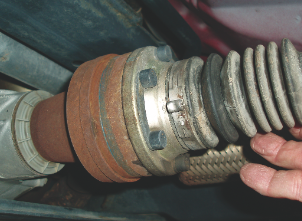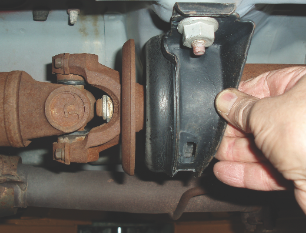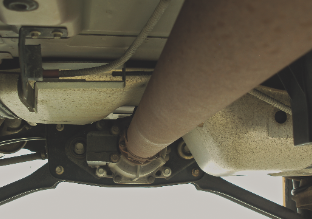 In modern automotive architecture, universal joints are most commonly found on the rear axles of light trucks, SUVs and RWD passenger cars. While some low-angle joints are made with a rubber-compounded material, most modern universal joints are made of a steel cross connecting four trunnions containing lubricated needle bearings. See Photo 1.
In modern automotive architecture, universal joints are most commonly found on the rear axles of light trucks, SUVs and RWD passenger cars. While some low-angle joints are made with a rubber-compounded material, most modern universal joints are made of a steel cross connecting four trunnions containing lubricated needle bearings. See Photo 1.
Eventually, the needle bearings wear grooves into the case-hardened surfaces of the cross, which allows the propeller shaft to rotate slightly off-center. The rule-of-thumb spec for off-center rotation is generally 0.010” measured at the end of the propeller shaft tube. In the most catastrophic cases, the lubricant in the trunnion bearings can be lost, which will cause the joint to separate.
Larger universal joints can be inspected for extreme wear by twisting the propeller shaft back and forth. Smaller joints can be tested by prying the trunnions back and forth with a large screwdriver. Preventive inspections can be made by watching for rust formations around the trunnion seal indicating that the trunnion has lost its lubrication. In another case, the driver might complain of a snapping or popping sound at low speed, which might indicate that the trunnions are seizing due to lack of lubrication. Seizing can be diagnosed only by removing the propeller shaft and checking each universal joint for smooth operation by hand. See Photo 2. 
Because the trunnion bearings are located at 90-degree intervals, a conventional universal joint actually accelerates and decelerates as it turns.
To eliminate this uneven rotating speed, universal joints are installed in pairs and phased along the same plane on the propeller shaft. When the U-joints are correctly phased, the propeller shaft speed smooths out because one U-joint accelerates as its companion joint decelerates. Unfortunately, some splined two-piece truck propeller shafts can be incorrectly phased during reassembly. This condition can be difficult to detect since incorrect phasing often results in a harmonic vibration that resonates under different conditions of speed and load. For this reason, it’s always important to index the propeller shaft to its mating flanges and to its individual parts before replacing universal joints.
Harmonic vibrations can also be caused by universal joints operating at unequal angles of deflection at the propeller shaft. These angles should be measured with the vehicle at normal suspension height and load. In some applications, the angle at the rear axle can be adjusted, either with shims or by a control arm eccentric, to allow the rear axle pinion gear shaft to operate in the same plane as the transmission. See Photo 3. 
Using a hand-held universal joint press will prevent damage to the propeller shaft, as will soaking the joint in penetrating oil before removal. If required, pack the needle bearings with chassis grease and always lubricate the propeller shaft loops before assembly. If used, grease zerks should point toward the propeller shaft and be aligned along the same plane. If the U-joint feels too stiff after it has been installed, align the trunnions by tapping the propeller shaft loops with a medium-sized hammer.












